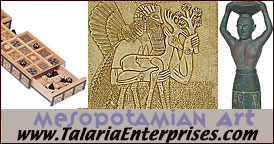
After the fall of the Assyrian and Babylonian Empires, the Persian Empire absorbed Mesopotamia & divided the area into two territories: north – Assyria & south – Babylonia. The Persian Empire was immense & relatively peaceful, in comparison to previous warring Mesopotamian empires. Persian kings accepted different cultural traditions & religious beliefs. Persian territories were grateful for the protection which the Empire provided as demonstrated in “The Great Stairway Procession Relief.”
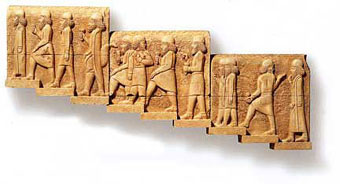
Palace of Darius, Great Stairway Procession Relief (4307 Retired)
ANCIENT MESOPOTAMIAN DEVELOPMENT
King Darius I built his extraordinary Palace at Persepolis, Persia, around c.500 BC. The relief is just a minute section of the Stairway that was part of the ‘Great Hallway.’ At the end of it, Darius I received dignitaries as they extended their respects & paid their levies & taxes.
Mesopotamia’s importance began when agricultural communities emerged, around 4000-3000 BC. The annual flooding of the river was a major contribution to their early development. Receding rivers left deposits of nutrients which created fertile soil where abundant agricultural products could be grown consistently. Mesopotamia was the land between the two rivers, Tigris & Euphrates, which originated in Turkey, flowed from north to south through Iraq & Kuwait & emptied into the Persian Gulf.
Communities could trade their excess agricultural products with other groups for valued commodities, such as metals, stones & woods. With food in reserve & imported building materials, Mesopotamia’s complex urbanization developed early.
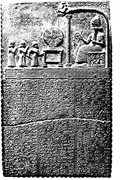
Shamash Tablet Cuneiform
Sumer established its Early Dynastic Period, (3200-2390 BC) & had stable city-states with kings, government, religion, writing & specialized human skills. Sumerians developed controlled flooding, built ziggurats(a combination of temples & government offices), strong-walled communities, & used wooden wheels, ploughs & ship oars. All of these extraordinary accomplishments establishes Mesopotamia as the ‘Cradle of Civilization.’
One major Sumerian invention, 3400 BC, was wedge-shaped (cuneiform) writing on clay slabs, called tablets. They were oven-fired which made the tablets firm like pottery. Protected by individual clay envelopes, the tablets were stored in libraries & available as reference materials. Libraries were a treasured resource & helped to advance knowledge throughout the local regions & beyond. The tablets were copied & dealt with all areas of society, from legal, financial, historical, religious to the 12 literary tablets containing the “Epic of Gilgamesh.”

Gigamesh from Louvre, Paris (4342 Retired)
Sumerian Hero, King Gilgamesh, was considered by Mesopotamian inhabitants as the originator of Sumer. The original 14 foot, full-sized standing alabaster wall-relief shows Gilgamesh mastering a lion. The artwork was discovered in the Throne Room at the Palace Sargon II, Dur-Sharrukin (today Khorsabad), & currently is in the Louvre, Paris.
The Gilgamesh Legend is about the adventures of a hero who attempts to gain an understanding of ‘Life’s Purposes.’Gilgamesh recorded his story on clay tablets. 600 years later, a story-teller wrote the legend as an epic poem on 12 tablets. Those tablets were copied & recopied as the legend was integrated into other Mesopotamian cultures.
Today, extensive research is being done on deciphering the 12 tablets accurately, because several Bible stories, such as Noah & the Great Flood, are also in the “Epic of Gilgamesh.”
RISE OF THE AKKADIANS
Arabian immigrants settled in Sumerian city-states north of Sumer, adopted Sumerian gods & culture, & between 2390-2214 BC, were the dominant political rulers known as Akkadians.
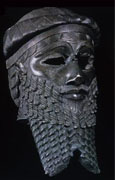
Sargon of Akkad (4230 Retired)
The sculpture, “Sargon of Akkad” (also known as) “Head of an Akkadian Ruler,” was created between c.2300-2200 BC & found in Nineveh, the city where most Assyrian kings built their palaces. Currently, the sculpture is in the Iraq Museum, Baghdad. The 12” artwork was expertly crafted from bronze with Sumerian styles of headdress & an elaborate beard treatment. The stylized treatments contrasts sharply with the rest of the naturalistic face. Originally, polished stones were in the eye sockets & the sculpture has a haunting presence without them. “Sargon of Akkad” is one of the World’s great artworks for the artist’s technique and the message of strength associated with this leader.
ASSYRIAN DEVELOPMENT
Assyrians descended from Arabian nomads who settled in Northern Mesopotamia where conditions were more difficult than in Southern Mesopotamia. The land was not well-suited for agriculture so trading was essential for survival. They had easily crossed flat-land, had no military defenses, and were in close proximity to stronger civilizations. This made the Assyrians vulnerable to hostile & invading cultures and empires.
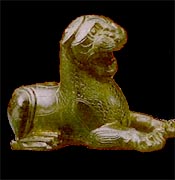
Assyrian Seated Lion (4343 Retired)
As a results, Assyrian kings established a garrison-state with defendable walled-cities & raided neighboring cultures. Eventually, they conquered other territories & peoples with the intention of ruling the then ‘Known World.’
The Assyrians most successful period of rule was the Neo-Assyrian (Late) Empire which lasted three centuries from 911-612 BC. At its height, the Assyrian Empire extended north almost to the Black Sea, southeast to the Persian Gulf, across the northern Arabian Desert, south to Thebes, Egypt, followed the Mediterranean coastline north beyond Tarsus, Anatolia and back across to the south of the Black Sea.
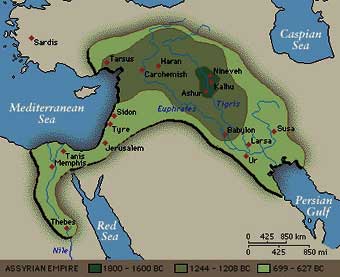
Map of Assyria provided from Ninevah.com
In order to maintain dominance in Mesopotamia & beyond, the stability of the Assyrian Empire depended on an individual king’s strengths.
Ashurnasirpal II ruled from 884-859 BC & was one of their most forceful kings. He expanded the Empire, except in Southern Mesopotamia where he wisely left powerful Babylonia alone.
ASSYRIAN KING’S PALACE
Within the outer walls of palaces were elaborate divisions of units. Included were open spaces, temples, ziggurats, other buildings and the main residence of the king.
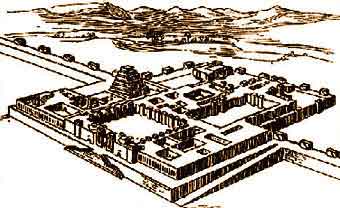
Palace of Sargon, Illustration
The main residence’s entry walls & throne-room were meant to impress and overwhelm the visitor. They were filled with elaborately painted visual records of narrative illustrations commemorating military conquests over peoples, their lands and animals.
Other areas of the palace had protective figures and images of the king with his retinue performing ritual acts.
The original dimensional, stone sculpture of “King Ashurnasirpal II” was erected in the Shrine of Ishtar at the King’s Palace in Calah (today Nimrud). He is holding the ‘Mace of Authority’ in his left hand & stands respectfully anticipating Ishtar’s favors & blessings.

Ashurnasirpal II (3528 retired)
Depictions of kings & important people were left facing a god in temples. Whenever cultures were overrun by enemies, valuable stones & metals would be stripped from artworks. The “Ashurnasipal II”stone sculpture probably survived because it did not have any valuables on it.
Coming up in Part Two………Mesopotamian Deities and the Last Great Assyrian King. Which spirits controlled the realm of the unseen, and which king ruled the land of the living?
All here and more, when Mesopotamia: Ancient Assyrian Art returns…..
